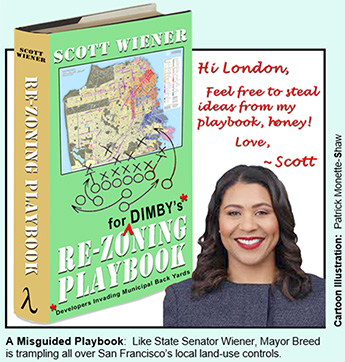 Article in Press Printer-friendly PDF file
Article in Press Printer-friendly PDF fileWestside Observer Newspaper
July-August 2019 at www.WestsideObserver.com
A Land-Grab, by Any Ohter Name, Developers Will Love
Breed's Blank Check: Re-Zoning Public Lands
 Article in Press Printer-friendly PDF file
Article in Press Printer-friendly PDF file
Westside Observer
Newspaper
July-August 2019 at www.WestsideObserver.com
A Land-Grab, by Any Ohter Name, Developers Will Love
Breed's Blank Check: Re-Zoning Public Lands
by Patrick Monette-Shaw
Mayor London Breed should be commended for advocating for more affordable housing development in the City. Lord only knows how desperately it’s needed.
But she’s playing from State Senator Scott Wiener’s disastrous re-zoning playbook. As everybody knows, Wiener’s failed SB-827 and SB-50 both involved housing legislation that would have undermined a long list of local controls over residential housing development up and down the state.
Similarly, Breed is trying to override neighborhood input into housing projects by trampling all over San Francisco’s local land-use controls.
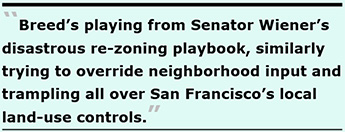 Observers wonder what she and Wiener are smoking in the hookah bubbling noisily at their feet. Or if the pair of them are just pandering to developers expecting quid pro quo campaign contributions in exchange for re-zoning the City or the state.
Observers wonder what she and Wiener are smoking in the hookah bubbling noisily at their feet. Or if the pair of them are just pandering to developers expecting quid pro quo campaign contributions in exchange for re-zoning the City or the state.
News has surfaced Breed is putting three ballot measures on the ballot this November — a $600 million general obligation bond; a Charter change measure to hand 100% affordable housing projects “by-right” status that will deprive neighborhoods of input during public appeals and discretionary reviews, and prevent challenges under CEQA; and an Ordinance to re-zone all public land (except Park and Recreation property) to permit housing where residential housing is currently prohibited.
The San Francisco Chronicle reported April 24, 2019 that Breed needs eight votes by the Board of Supervisors to place the housing bond on the ballot, just six votes to put the Charter change on the ballot (she only has three votes at this point), and she can place the re-zoning measure on the ballot with the stroke of her single pen.
All three measures have serious problems.
Of the three measures, until June 18 voters had only seen the barest of preliminary information about one of them, the bond measure. There weren’t any public-facing documents before then showing the actual or proposed legal language of the Charter change or the re-zoning Ordinance, or final language for the bond measure.
This article focuses on the re-zoning measure, arguably the worst of the bunch. The Westside Observer will address the other two ballot measures in future articles.
 Citywide Re-Zoning of Public Lands
Citywide Re-Zoning of Public Lands
Breed’s proposal to re-zone public lands across the entire City reeks of Wiener’s various trickle-down housing theories designed to override local planning rules.
On April 24, Jay Barmann at sfist.com may have inaccurately reported Breed will “need supervisor support to get [her re-zoning measure] on the ballot.” That Breed may need any Supervisors to place the public parcels re-zoning on November’s ballot is inaccurate. First of all was her own claim on June 11 she doesn’t have to get City Supervisors to help her place it on the ballot, to her apparent relief.
On June 11, Breed staged a press conference about the City purchasing a site at 1515 South Van Ness from Lennar Multifamily Properties for “around” $18.5 million for a 100%-affordable housing project.
A partial verbatim transcript of Breed’s press conference posted on SFGOV-TV reveals Breed stated:
“We have to be aggressive when it comes to getting more housing in the City. … The other thing that I’m proposing is an Ordinance, which I don’t have to go to the Board of Supervisors [for], thank goodness. We’re going to put an Ordinance on the ballot that will re-zone all public property. … When we have an opportunity on public property that’s underutilized to build 100% affordable or teacher housing, we can do it without going through a lengthy two-year re-zoning planning process. … We’re going to have to do things differently [like changing zoning regulations].”
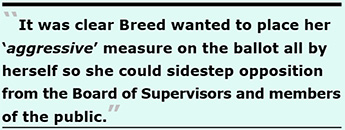 It was clear Breed wanted to place her “aggressive” measure on the ballot all by herself so she could sidestep opposition from the Board of Supervisors and members of the public.
It was clear Breed wanted to place her “aggressive” measure on the ballot all by herself so she could sidestep opposition from the Board of Supervisors and members of the public.
As an aside, Lennar purchased the property in December 2015 for $12.8 million so it will see a 44.5% percent increase on its initial investment by selling it for $18.5 million. The Mission Local web site reported that, somewhat ironically, Breed noted “We have the money to buy the site, but we don’t have money to build it.”
Second, the Department of Elections confirmed in late April that Breed’s proposed Ordinance to re-zone all public property doesn’t need anybody to help her place it on the ballot.
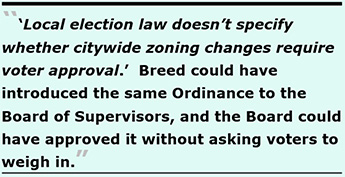 The Mayor is allowed to place Ordinances — but not Charter changes — directly onto the ballot without four or six Supervisors, per Charter Section 3.100.16. Elections reported:
The Mayor is allowed to place Ordinances — but not Charter changes — directly onto the ballot without four or six Supervisors, per Charter Section 3.100.16. Elections reported:
“Only the Board [of Supervisors] or voters can approve Ordinances, the Mayor does not have such authority. Local election law doesn’t specify whether citywide zoning changes require voter approval. … Depending on the subject matter, the Board can pass Ordinances without voter approval.”
Rather than seeking voter approval to pass a mere Ordinance, Breed could have introduced the same Ordinance to the Board of Supervisors, and the Board could have approved it without asking voters to weigh in. They’ve done so before. Breed must have known that introducing such a citywide re-zoning Ordinance for Board approval would face tough opposition.
Clearly, when Breed placed the re-zoning measure on the ballot all by herself, she must have also understood that she would be depriving both members of the public and the Board of Supervisors of any public debate or discussion about the merits — or lack thereof — of her proposal.
Teacher Housing Project at Francis Scott Key Annex Misinformation
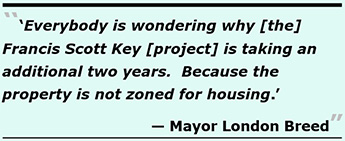 During Breed’s June 11 press conference, she baldly implied delays with the teacher housing project at 43rd & Irving are due solely to zoning issues. Breed claimed:
During Breed’s June 11 press conference, she baldly implied delays with the teacher housing project at 43rd & Irving are due solely to zoning issues. Breed claimed:
“Everybody is wondering why [the] Francis Scott Key [project] is taking an additional two years. Merna Melgar [Vice President of the San Francisco Planning Commission] could tell you why it’s taken an additional two years: Because the property is not zoned for housing.”
That’s pure nonsense. The delay was caused by multiple factors, re-zoning being the least of them.
The Chronicle also reported April 24 that former Mayor Lee had earmarked $44 million in 2017 to build up to 150 units of teacher housing at the Francis Scott Key site. The Chronicle whined:
“Nearly two years later, developers have yet to break ground, in part because they had to apply to rezone the parcel …”
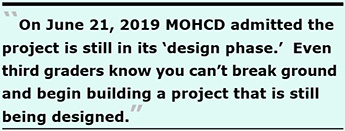 That’s more nonsense, but not unexpected of the Chronicle, Breed’s shill. If there’s been a two-year delay on that project, it could be that on June 21, 2019 the Mayor’s Office of Housing and Community Development (MOHCD) finally admitted the project is still in its “design phase,” which the Chronicle should have asked, and known, about. Even third graders know you can’t break ground and begin building a project that is still being designed.
That’s more nonsense, but not unexpected of the Chronicle, Breed’s shill. If there’s been a two-year delay on that project, it could be that on June 21, 2019 the Mayor’s Office of Housing and Community Development (MOHCD) finally admitted the project is still in its “design phase,” which the Chronicle should have asked, and known, about. Even third graders know you can’t break ground and begin building a project that is still being designed.
The reason the teacher housing project at Francis Scott Key hasn’t broken ground yet isn’t due just to a zoning squabble. The Chronicle, Breed’s mimicking mouthpiece, mentions nothing about other bureaucratic delays involving larger issues.
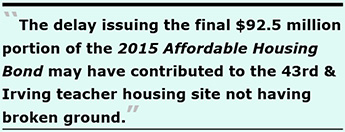 Comically, the Chronicle mentioned nothing about the three-and-a-half year delay during which MOHCD has stalled issuing the third and final $92.5 million portion, or tranche — fully 30% — of the $310 million 2015 Affordable Housing Bond that won’t be issued until the Fall of 2019, nearly four years after voters approved it in 2015. The delay issuing the bonds may have contributed to the 43rd & Irving teacher housing site not having broken ground, as the Chronicle also should also know.
Comically, the Chronicle mentioned nothing about the three-and-a-half year delay during which MOHCD has stalled issuing the third and final $92.5 million portion, or tranche — fully 30% — of the $310 million 2015 Affordable Housing Bond that won’t be issued until the Fall of 2019, nearly four years after voters approved it in 2015. The delay issuing the bonds may have contributed to the 43rd & Irving teacher housing site not having broken ground, as the Chronicle also should also know.
After Lee committed to the Francis Scott Key site in 2017, MOHCD began reporting to CGOBOC (the Citizen’s General Obligation Bond Oversight Committee) in September 2017 that the 43rd & Irving teacher housing project would be funded, in part, from the November 2015 $310 million Affordable Housing Bond. Of interest, MOHCD first indicated in September 2017, and has consistently claimed since then, that the project would involve just 82 middle-income units for teacher’s, not the 150 units as Lee had proposed. That’s a 45.3% change decline in the number of teacher units at the Francis Scott Key Annex site, with no explanation offered as to why the number of units had plunged.
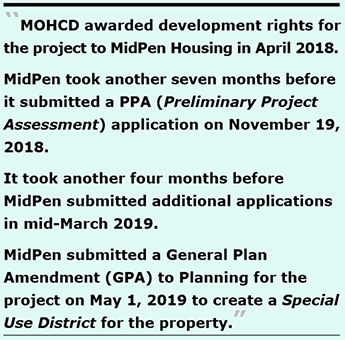 A month later, MOHCD issued a Request for Development Proposals for educator rental housing on October 3, 2017. Six months later, at the recommendation of a selection panel, MOHCD awarded development rights for the project to MidPen Housing in April 2018; MOHCD encumbered $3 million in predevelopment funding to MidPen in 2018. As of March 31, 2019, only $304,931 has been disbursed; it’s not known when the remaining $2.7 million will be disbursed or what may be causing the disbursement delay. Perhaps Mayor Breed, or the Chronicle, knows. Perhaps it hasn’t been disbursed because the project is still being designed.
A month later, MOHCD issued a Request for Development Proposals for educator rental housing on October 3, 2017. Six months later, at the recommendation of a selection panel, MOHCD awarded development rights for the project to MidPen Housing in April 2018; MOHCD encumbered $3 million in predevelopment funding to MidPen in 2018. As of March 31, 2019, only $304,931 has been disbursed; it’s not known when the remaining $2.7 million will be disbursed or what may be causing the disbursement delay. Perhaps Mayor Breed, or the Chronicle, knows. Perhaps it hasn’t been disbursed because the project is still being designed.
MidPen then took another seven months before it submitted to the Planning Department a Preliminary Project Assessment (PPA) application proposing 134 dwelling units for the teacher housing project on November 19, 2018. It took nearly 14 months between October 2017 and November 2018 to advance from requesting development proposals to seeing a PPA application submitted to Planning. PPA’s are essentially the first step with the Planning Department, even before zoning issues can be addressed.
Why MidPen told Planning in November 2018 it was applying to develop a 134-unit project — after MOHCD had previously reported to CGOBOC for months that an 82-unit project for middle-income households would be built at the Francis Scott Key site, isn’t fully known. There had been no explanation about that disconnect, but MOHCD finally reported on June 21 that the 52-unit disconnect between 134 and 82 units will be for low-income households (presumably earning 80% of AMI — $66,300 for a one-person household — or less), and the precise number of units isn’t known because the project is still in the “design phase” and still subject to change. MOHCD has not reported to CGOBOC that the Francis Scott Key site will involve low-income educator housing.
It took another four months from November 2018 before MidPen submitted additional applications for the project to Planning in mid-March 2019, including an Environmental application (ENV), a Project Profile (PRJ), a Zoning Map Amendment (MAP), and a Planning Code Amendment (PCA).
A month-and-a-half later, MidPen submitted a General Plan Amendment (GPA) to Planning for the project on May 1, 2019 to create a Special Use District for the property. The five applications (not including the PPA) all remain under review at Planning. It should be noted that the Board of Supervisors have routinely re-zoned parcels — and do so relatively quickly — and have approved Special Use Districts without obtaining voter approval beforehand, since that is within the Board’s legislative purview and they don’t need to seek voter approval.
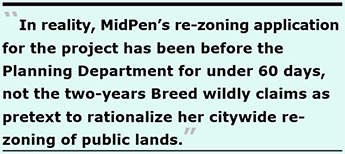 So, in reality, MidPen’s re-zoning application for the project has been before the Planning Department for under 60 days since May 2019 (as of this writing in June), not the two-years Breed wildly claims as pretext to rationalize her citywide re-zoning of public lands. Why didn’t MidPen apply for the Special Use District status in April 2018 instead of in May 2019, eliminating one year of delay?
So, in reality, MidPen’s re-zoning application for the project has been before the Planning Department for under 60 days since May 2019 (as of this writing in June), not the two-years Breed wildly claims as pretext to rationalize her citywide re-zoning of public lands. Why didn’t MidPen apply for the Special Use District status in April 2018 instead of in May 2019, eliminating one year of delay?
If there are bureaucratic barriers that need to be fixed to speed up housing production, it’s not just the re-zoning component, but other processes at MOHCD and City Hall that need to be streamlined.
As of June 17, 2019, the Planning Department reports “No project-specific hearings or re-zoning hearings have taken place, nor have any been scheduled” by either the Planning Commission or the Board of Supervisors on the Francis Scott Key Annex re-zoning application.
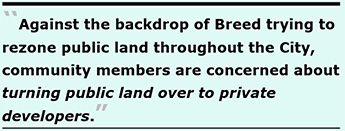 “Against the Interest of the People”
“Against the Interest of the People”
Against the backdrop of Breed trying to re-zone public land throughout the City, the San Francisco Examiner reported June 15 that another housing project (not only for teachers) proposed for Balboa Reservoir is against the interests of the community.
Community members are concerned selling public land to private investors is a bad idea. Labor journalist and City College advocate Steve Zelzter said:
“You are turning public land over to private developers — it’s against the interest of the people of San Francisco. We should not trust developers to take care of our interests and needs.”
The Examiner article went on to note that Planning Commission president Rich Hillis said:
“We prioritize housing on public land. We have to make these tradeoffs to leverage the economic value of this land to build at these levels — which are huge at 50 percent affordable housing. This process is at the beginning, there will be an [environmental review] where we will look at density and traffic [issues].”
It’s not clear whether Hillis understands that the Planning Commission currently doesn’t have authority to approve placing housing on public land, unless the parcel is being re-zoned as a Special Use District or re-zoned on a project-by- project discretionary basis, given that the zoning code prohibits placing residential housing on any Public (P) parcels.
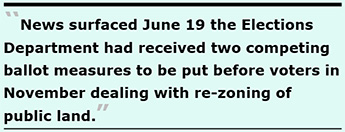 Dueling Ballot Measures
Dueling Ballot Measures
News surfaced Wednesday, June 19 that the Elections Department had received two competing ballot measures the day before to be put before voters in November dealing with re-zoning of public land: One ordinance was submitted by Breed — Accelerating Affordable Housing and Affordable Teacher Housing Program. The second ordinance — Affordable Homes for Educators and Families Now was submitted by four Supervisors (Supervisors Peskin, Fewer, Walton, and Haney — the latter three of whom had formerly served as president of the School Board). It’s not fully clear yet how the two measures differ, and over what issues, but a side-by-side comparison sheds some light on the differences.
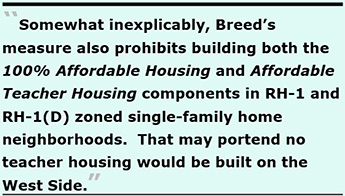 A quick reading of the Affordable Teacher Housing Program component of Breed’s proposal requires that no less than two-thirds of the housing units must be deed restricted for affordable units. The other third can apparently be market-rate units (on the public land re-zoned to allow housing). That’s essentially a giveaway to Senator Wiener’s and Breed’s developer friends and campaign donors, and amounts to awarding public lands to DIMBY’s (Developers Invading Municipal Back Yards).
A quick reading of the Affordable Teacher Housing Program component of Breed’s proposal requires that no less than two-thirds of the housing units must be deed restricted for affordable units. The other third can apparently be market-rate units (on the public land re-zoned to allow housing). That’s essentially a giveaway to Senator Wiener’s and Breed’s developer friends and campaign donors, and amounts to awarding public lands to DIMBY’s (Developers Invading Municipal Back Yards).
Somewhat inexplicably, Breed’s measure also prohibits building both the 100% Affordable Housing and Affordable Teacher Housing components in RH-1 and RH-1(D) zoned single-family home neighborhoods. That may portend no teacher housing would be built on the West Side. (The Balboa Reservoir housing site is in District 7 and the Francis Scott Key Annex teacher housing site is in D-4).
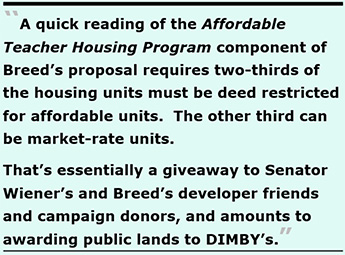 There are other differences between the two dueling ballot measures, including the maximum allowable Area Median Income (AMI) percentages, and increases in proposed heights of the projects. Breed’s measure would define eligibility “Affordable Teacher Housing Projects” as earning up to 140% of AMI, which is $116,050 for a one-person household, and up to $165,750 for a four-person household (two parents with two kids).
There are other differences between the two dueling ballot measures, including the maximum allowable Area Median Income (AMI) percentages, and increases in proposed heights of the projects. Breed’s measure would define eligibility “Affordable Teacher Housing Projects” as earning up to 140% of AMI, which is $116,050 for a one-person household, and up to $165,750 for a four-person household (two parents with two kids).
Breed’s measure contains a poison pill that includes Section 7, titled “Conflicting Measures,” which says that in the event her Ordinance and any other measure(s) regarding 100% affordable teacher housing and regulation of Public (P) zoned districts appear on the same election ballot, then the other measure(s) shall “be deemed to be in conflict” and her Ordinance will prevail (provided that she receives more affirmative votes), and the other measure(s) “shall be null and void in their entirety.”
Breed’s measure was submitted by fiat, because she reportedly didn’t engage the Board of Supervisors — let alone members of the public — as a stakeholder before she submitted her ballot measure.
 According to a City Hall source who spoke on condition of anonymity, the Board of Supervisors “only saw the Mayor’s proposal” the night before she submitted it to the Elections Department on June 18. The source noted:
According to a City Hall source who spoke on condition of anonymity, the Board of Supervisors “only saw the Mayor’s proposal” the night before she submitted it to the Elections Department on June 18. The source noted:
“I think the Supervisors were clear in their statements at the Board’s meeting [on June 18] that they would prefer to do this work legislatively at the Board. But given that the Mayor has refused to sit down with the Legislative branch about any of her [three ballot measure] proposals, this [dueling measure] creates space to negotiate and work toward a compromise.”
There you have it: Breed prefers to work by fiat, rather than working collaboratively with the Board of Supervisors.
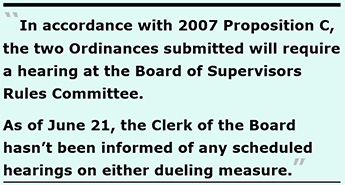 In accordance with 2007 Proposition C, the two Ordinances submitted to the Department of Elections will require a hearing at the Board of Supervisors Rules Committee, but only at the discretion of the Rules Committee chairperson. As of June 21, the Clerk of the Board hasn’t been informed of any scheduled hearings on either of the dueling measures.
In accordance with 2007 Proposition C, the two Ordinances submitted to the Department of Elections will require a hearing at the Board of Supervisors Rules Committee, but only at the discretion of the Rules Committee chairperson. As of June 21, the Clerk of the Board hasn’t been informed of any scheduled hearings on either of the dueling measures.
City Charter Section 2.113 requires that before an ordinance proposed by the Mayor can appear on a ballot, the Mayor must provide the ordinance to the Board of Supervisors for assignment to a Board sub-committee for a public hearing on the measure at least 15 days prior to the deadline for the submission of such initiatives to the Department of Elections. During such a hearing, the Board’s committee members cannot modify the ordinance the Mayor authors. That deadline is August 2.
Failure of the Board of Supervisors to hold a hearing on the measure prior to the Department of Elections’ deadlines doesn’t prevent the Director of Elections from putting Breed’s initiative on the ballot. If the Mayor withdraws her measure, the Board of Supervisors isn’t required to conduct a hearing.
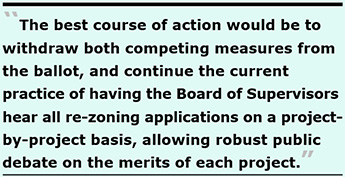 While the Board of Supervisors may hope to schedule a hearing about the measure the four Supervisors submitted to the Elections Department [but also didn’t hold a hearing on before submitting it], any such hearings need to be held in the next three weeks before July 22 to deal with Department of Elections deadlines. If a single compromise measure is reached between the Mayor and the Board of Supervisors, they have until August 2 to submit a revised, consolidated measure to Elections.
While the Board of Supervisors may hope to schedule a hearing about the measure the four Supervisors submitted to the Elections Department [but also didn’t hold a hearing on before submitting it], any such hearings need to be held in the next three weeks before July 22 to deal with Department of Elections deadlines. If a single compromise measure is reached between the Mayor and the Board of Supervisors, they have until August 2 to submit a revised, consolidated measure to Elections.
The best course of action would be to withdraw both competing measures from the ballot, and continue the current practice of having the Board of Supervisors hear all re-zoning applications on a project-by-project basis, allowing robust public debate on the merits and impacts of a given housing project on the affected neighborhoods.
Disconnect on Number of Parcels Zoned Public
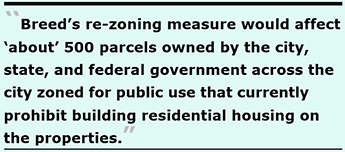 The Chronicle’s April 24 article noted Breed’s re-zoning measure would affect “about” 500 parcels owned by the city, state, and federal government across the city zoned for public use that currently prohibit building residential housing on the properties. How Breed’s measure can re-zone parcels owned by the state or the federal government is not clear.
The Chronicle’s April 24 article noted Breed’s re-zoning measure would affect “about” 500 parcels owned by the city, state, and federal government across the city zoned for public use that currently prohibit building residential housing on the properties. How Breed’s measure can re-zone parcels owned by the state or the federal government is not clear.
Breed has also asserted that her measure would affect 500 parcels currently zoned Public (P).
In June 2018, the Planning Department provided a list of 930 parcels currently zoned as “Public (P)” by various Assessor “Use Types.” Weirdly, the list did not include a category for “Recreation and Parks” properties.
Table 1: Public (P) Parcels by Assessor Use Type
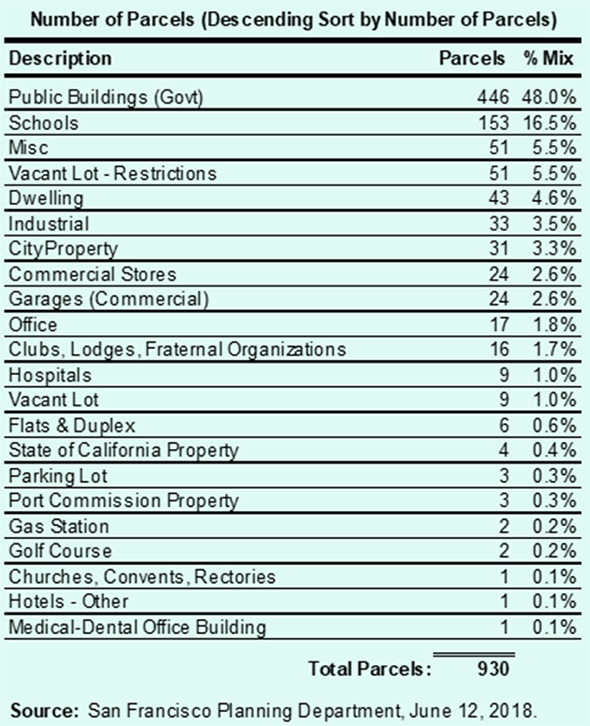
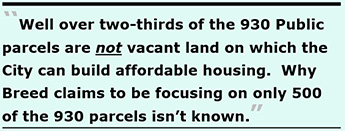 The list above shows that well over two-thirds of the 930 Public parcels are not vacant land on which the City can build affordable housing. Why Breed claims to be focusing on only 500 of the 930 parcels isn’t known.
The list above shows that well over two-thirds of the 930 Public parcels are not vacant land on which the City can build affordable housing. Why Breed claims to be focusing on only 500 of the 930 parcels isn’t known.
The nine parcels for hospitals are our public hospitals at SFGH and Laguna Honda Hospital, which represent just 0.98% of the 930 parcels that we may need (and should reserve) for medical facilities, rather than housing, in the future.
Obviously, there’s no room on SFGH’s campus to add housing projects, and LHH’s property should be retained as a “rainy-day” site for expanding medical facilities, additional skilled nursing facility beds, and assisted living facilities, particularly as the City’s population grows and ages during the next decades. SFGH may one day need land at LHH to expand SFGH’s acute services.
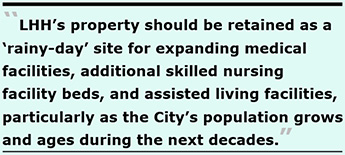 Breed’s re-zoning ballot measure doesn’t mention any exemption carve-outs for Public parcels other than for parks. It’s not known if Breed and the Chronicle are excluding from the 930 parcels any property in RH-1 and RH-1(D) single-family neighborhoods to arrive at just 500 parcels.
Breed’s re-zoning ballot measure doesn’t mention any exemption carve-outs for Public parcels other than for parks. It’s not known if Breed and the Chronicle are excluding from the 930 parcels any property in RH-1 and RH-1(D) single-family neighborhoods to arrive at just 500 parcels.
If there is going to be a re-zoning carve-out exempting Rec and Park property, there should also be a carve-out exemption for “P” parcels that have an Assessor’s “Use Type” of hospitals on public land.
Laguna Honda Hospital Land Grab
In 2005, the Health Department proposed utilizing LHH as a social rehabilitation center for the urban poor to provide mental health services. In response, healthcare advocates (including me) placed Prop. “D” on the June 2006 ballot to re-zone LHH’s campus for only elderly and disabled San Franciscans, since mixing behaviorally assaultive patients with the elderly was dangerous and not conducive to proper healthcare for either patient population.
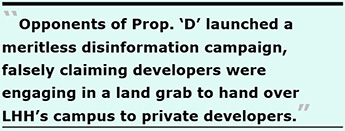 Opponents of Prop. “D” launched a meritless and brutal disinformation campaign in 2006, falsely claiming the Residential Builders Association and other developers were engaging in a land grab to hand over LHH’s campus to private developers. The hysteria that ensued sank Prop. “D,” which voters rejected perhaps in part to the fearmongering of turning over public land to private developers.
Opponents of Prop. “D” launched a meritless and brutal disinformation campaign in 2006, falsely claiming the Residential Builders Association and other developers were engaging in a land grab to hand over LHH’s campus to private developers. The hysteria that ensued sank Prop. “D,” which voters rejected perhaps in part to the fearmongering of turning over public land to private developers.
Ironically, Breed now wants voters to approve re-zoning all public parcels (except parks) to hand over to private developers.
The Westside Observer reported in July 2018 that in March 2018 Supervisor Yee began pitching a proposal to MOHCD to build a six-story building with up to 160 units of housing for seniors on LHH’s campus, with a full spectrum of options for those who need assisted living, skilled nursing, and independent living.
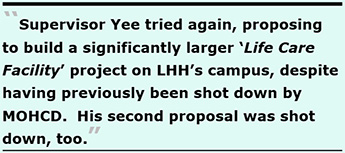 MOHCD’s director, Kate Hartley shot Yee down, by flatly ruling out building either assisted living or Residential Care Facilities for the Elderly (RCFE) units on LHH’s campus, saying LHH’s site “wasn’t big enough” and was too small (which is patently ridiculous on its face). Hartley also noted LHH’s campus is a Public (P) parcel that is prohibited from residential housing.
MOHCD’s director, Kate Hartley shot Yee down, by flatly ruling out building either assisted living or Residential Care Facilities for the Elderly (RCFE) units on LHH’s campus, saying LHH’s site “wasn’t big enough” and was too small (which is patently ridiculous on its face). Hartley also noted LHH’s campus is a Public (P) parcel that is prohibited from residential housing.
Supervisor Yee tried again in December 2018, proposing to build a significantly larger project on LHH’s campus, despite having previously been shot down by MOHCD. Yee pitched constructing a “Life Care Facility” with up to five different project components, and that proposal was shot down, too.
Obviously, if LHH’s site is “too small” it shouldn’t be re-zoned to build market-rate teacher housing on the property!
Sadly, while the two competing ballot measures provide a carve out for educator housing on public lands, both mention nothing about building affordable housing for seniors who need assisted living units on public land.
Indeed, the City is planning to renovate two wings in LHH’s old hospital that were supposed to have been torn down and rebuilt for assisted living facilities. Rather than using that land for assisted living as initially planned in 2008, the City has pledged to spend $60 million remodeling those two wings into office space for Department of Public Health staff currently located elsewhere throughout the City.
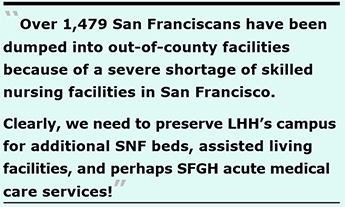 Over 1,479 San Franciscans have been dumped into out-of-county facilities by LHH, SFGH, and private hospitals between July 2006 and October 2018 because of a severe shortage of skilled nursing facilities (SNF), sub-acute care, and assisted living facilities in San Francisco. Clearly, we need to preserve LHH’s campus for additional SNF beds, assisted living facilities, and perhaps SFGH acute medical care services!
Over 1,479 San Franciscans have been dumped into out-of-county facilities by LHH, SFGH, and private hospitals between July 2006 and October 2018 because of a severe shortage of skilled nursing facilities (SNF), sub-acute care, and assisted living facilities in San Francisco. Clearly, we need to preserve LHH’s campus for additional SNF beds, assisted living facilities, and perhaps SFGH acute medical care services!
Secondarily, LHH has worked hard with community partners to develop hiking trails on LHH’s campus, such that its recreational land should also be exempt, even if it’s not formal RPD property. LHH’s campus is home to a mountain bike trail.
The Laguna Honda Community Trail project sponsored by the San Francisco Urban Riders has been improving and restoring over two miles of historic multi-use trails on the grounds of LHH since 2017, which has been funded in part by Supervisor Yee’s District 7 Participatory Budget, and funding support from the San Francisco Community Challenge Grant, the California Trails and Greenways Foundation, REI, and other local community supporters.
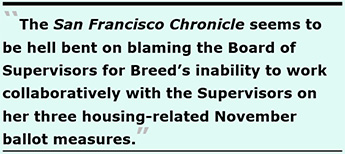 When completed the trails will complement Twin Peaks, Mount Sutro, and other neighboring trail systems and open spaces.
When completed the trails will complement Twin Peaks, Mount Sutro, and other neighboring trail systems and open spaces.
Chronicle Blames Supervisors
The San Francisco Chronicle seems to be hell bent on blaming the Board of Supervisors for Breed’s inability to work collaboratively with the Supervisors on her three housing-related November ballot measures, as if Breed shares no responsibility for her own housing policy decisions.
The Chronicle’s June 16 cover story, “Breed’s housing measure in peril,” by Dominic Fracassa carries a different headline on page A-17, reading “Breed struggles for consensus on housing.”
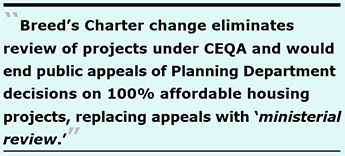 The story mainly focuses on Breed’s City Charter change measure to hand 100% affordable housing projects “by-right” status. She needs six Supervisors to co-sponsor placing the measure onto the November ballot, but currently has only three: Supervisors Vallie Brown (D-5), Ahsha Safai (D-11), and Catherine Stefani (D-2). The article notes it is “unlikely” she’ll pick up the three additional co-sponsors she needs. The reluctance of other Supervisors signing on to the measure is that the proposal itself may have problems, including reducing public input on proposed developments and placing it in the Charter essentially chisels the changes in stone.
The story mainly focuses on Breed’s City Charter change measure to hand 100% affordable housing projects “by-right” status. She needs six Supervisors to co-sponsor placing the measure onto the November ballot, but currently has only three: Supervisors Vallie Brown (D-5), Ahsha Safai (D-11), and Catherine Stefani (D-2). The article notes it is “unlikely” she’ll pick up the three additional co-sponsors she needs. The reluctance of other Supervisors signing on to the measure is that the proposal itself may have problems, including reducing public input on proposed developments and placing it in the Charter essentially chisels the changes in stone.
The language of Breed’s Charter change measure eliminates review of projects under CEQA (California’s Environmental Quality Act), and would end public appeals of Planning Department decisions on 100% affordable housing projects, replacing appeals with “ministerial review.” There’s also unease over what Breed defines as “affordable housing.”
The measure is titled “Non-Discretionary Review of 100% Affordable Housing and Teacher Housing Projects.” The title pretty much defines that the Charter change will eliminate discretionary reviews, and the legal text on line 8 on the first page reads “ministerial review in lieu of approvals by or certain appeals to City boards and commissions.”
 For his part, Supervisor Rafael Mandelman is concerned about eliminating public appeals. The Chronicle reported:
For his part, Supervisor Rafael Mandelman is concerned about eliminating public appeals. The Chronicle reported:
“Although appeals for additional reviews can delay developments and cause costs to balloon, Mandelman said it is important to allow residents to weigh in on proposed changes to their own neighborhoods. … There’s a lot of value in a role for the public and the ability to shape projects through (existing) processes. You’re losing something when you give that up, and it’s not insignificant.”
The article reports Jeff Cretan, the mayor’s spokesperson, said nobody from the Board of Supervisors “has requested … a meeting” to talk about Breed’s Charter change. But as noted above, the Board is frustrated that Breed has refused to sit down with the Legislative branch about any of her three proposed ballot measures. Both sides appear to be blaming the other side for not being able to coordinate getting together for a meeting.
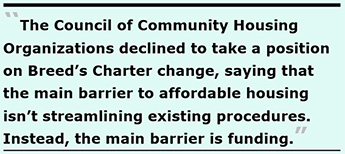 The Council of Community Housing Organizations (CCHO, pronounced Choo-Choo), co-chaired by Peter Cohen and Fernando Marti, reportedly declined to take a position on Breed’s Charter change, saying that the main barrier to affordable housing isn’t streamlining existing procedures. Instead, the main barrier is funding.
The Council of Community Housing Organizations (CCHO, pronounced Choo-Choo), co-chaired by Peter Cohen and Fernando Marti, reportedly declined to take a position on Breed’s Charter change, saying that the main barrier to affordable housing isn’t streamlining existing procedures. Instead, the main barrier is funding.
Breed has until July 26 to secure three more votes from the Board of Supervisors before submitting her Charter change language to the Elections Department.
The next day on June 17, the Chronicle published an editorial claiming that the Supervisors who have not signed on to Breed’s Charter change “appear determined to uphold the supervisors’ tradition of resisting every effort to ease residential development.” The Chron claimed this is the same Board that voted 9-to-2 against endorsing Senator Wiener’s disastrous SB-50 in April 2019.
This is not only nonsense, but revisionist history-making. Individually and collectively, the Board of Supervisors have made every effort to increase affordable housing development. And Wiener’s SB-50 received opposition from local legislators all over the state, from San Francisco to West Hollywood.
Senator Wiener’s Unethical “Gut-and-Amend”
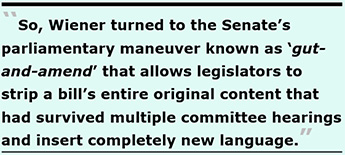 Wiener’s SB-50 had faced stiff opposition up and down the State, and thankfully was suspended in the Senate Appropriations Committee. He faced not being able to resurrect it until after January 2020, given Senate rules.
Wiener’s SB-50 had faced stiff opposition up and down the State, and thankfully was suspended in the Senate Appropriations Committee. He faced not being able to resurrect it until after January 2020, given Senate rules.
So, Wiener turned to his “Re-Zoning Playbook for DIMBY’s” and looked up the Senate’s parliamentary maneuver known as gut-and-amend that allows legislators to strip a bill’s entire original content that had survived multiple committee hearings and insert completely new language. Gut-and-amend lets legislators avoid vetting a bill, including public review, during transparent committee hearings, and to escape having to start at the beginning of the process.
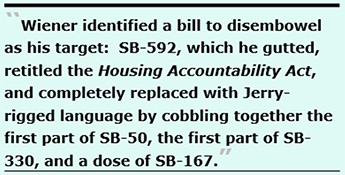 Then, Wiener identified a bill to disembowel as his target: SB-592 — a barber’s and cosmetologist’s licensing bill — that had successfully passed the Appropriations Committee. On June 12, 2019 he gutted SB-592, retitled it the Housing Accountability Act, and completely replaced with Jerry-rigged language from a hodgepodge of other bills by cobbling together the first part of SB-50, the first part of SB-330, and a dose of SB-167.
Then, Wiener identified a bill to disembowel as his target: SB-592 — a barber’s and cosmetologist’s licensing bill — that had successfully passed the Appropriations Committee. On June 12, 2019 he gutted SB-592, retitled it the Housing Accountability Act, and completely replaced with Jerry-rigged language from a hodgepodge of other bills by cobbling together the first part of SB-50, the first part of SB-330, and a dose of SB-167.
Gut-and-amend is a power play designed to avoid public or legislative scrutiny, and is considered to be an unethical abuse of process. Wiener’s sneaky-Pete goal is to pass legislation beneficial for housing developers and housing lobbyists by tossing aside the State Senate’s typical committee processes. And he doesn’t appear to care that he’s behaving unethically.
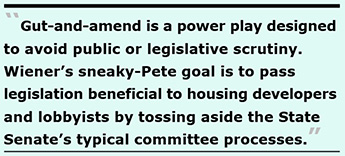 Breed’ Gambit: Redefine “Affordable”
Breed’ Gambit: Redefine “Affordable”
Not only would Breed’s separate Ordinance to re-zone all Public (P) parcels expand affordable teacher housing to 140% of AMI, her Charter change proposes increasing all 100% affordable housing projects for those (in addition to teachers) earning up to 140% of AMI, changing the definition of 100% affordable housing. That may contribute to why some members of the Board of Supervisors are hesitant to sign on to Breed’s Charter change measure.
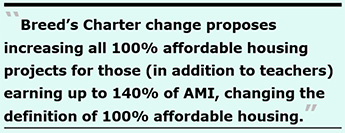 As noted above, those earning up to 140% of AMI includes those earning $116,050 for a one-person household and up to $165,750 for a four-person household (two parents with two kids). That raises the bar from other definitions of “affordable,” since the RHNA definition of “moderate income” is 80% to 120% of AMI, and “above moderate” is above 120% ($99,500 for a one-person household and $142,100 for a four-person household). Units for households earning above 120% is generally considered to be for market-rate units.
As noted above, those earning up to 140% of AMI includes those earning $116,050 for a one-person household and up to $165,750 for a four-person household (two parents with two kids). That raises the bar from other definitions of “affordable,” since the RHNA definition of “moderate income” is 80% to 120% of AMI, and “above moderate” is above 120% ($99,500 for a one-person household and $142,100 for a four-person household). Units for households earning above 120% is generally considered to be for market-rate units.
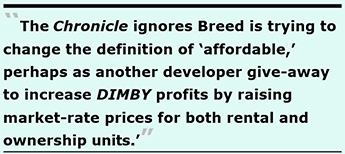 Separately, the City, through MOHCD, has a Teacher Next Door (TND) forgivable loan program for teacher households seeking to purchase a home that is funded, in part but not exclusively, by the 2015 and possibly the upcoming 2019 Affordable Housing bonds. Educators who can apply for the TND loans can earn up to 200% of AMI, which is $165,800 for a one-person household and up to $236,800 for a four-person household.
Separately, the City, through MOHCD, has a Teacher Next Door (TND) forgivable loan program for teacher households seeking to purchase a home that is funded, in part but not exclusively, by the 2015 and possibly the upcoming 2019 Affordable Housing bonds. Educators who can apply for the TND loans can earn up to 200% of AMI, which is $165,800 for a one-person household and up to $236,800 for a four-person household.
The Chronicle editorial argued objections to the Charter change would promote market-rate housing is simplistic. Claiming Breed’s Charter change measure “only applies” to affordable housing, the Chronicle ignores that Breed is trying to change the definition of “affordable,” perhaps as another developer give-away to increase DIMBY profits by raising market-rate prices for both rental and ownership units.
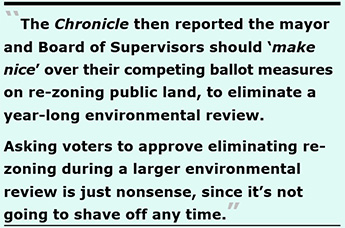 The Chronicle complained the Board isn’t expediting a “narrow subset” of residential housing development. But Breed’s Charter change is anything but “narrow.” It’s a broader, broad-changing Charter amendment that the Board should thoughtfully debate — if not reject outright — before placing it on the ballot.
The Chronicle complained the Board isn’t expediting a “narrow subset” of residential housing development. But Breed’s Charter change is anything but “narrow.” It’s a broader, broad-changing Charter amendment that the Board should thoughtfully debate — if not reject outright — before placing it on the ballot.
The Chronicle then reported in a third article on June 21 that the mayor and Board of Supervisors should “make nice” (an appalling phrase, if ever there was one) over their competing ballot measures on re-zoning public land to eliminate a year-long environmental review. This isn’t merely about “making nice.”
A sidebar to the Chronicle’s article reveals the re-zoning issue is considered during environmental review, the latter of which is not going to go away since neither of the competing ballot measures deals with whether environmental review will be completely eliminated. Asking voters to approve eliminating re-zoning during a larger environmental review is just nonsense, since it’s not going to shave off any time.
Table 2: MOHCD’s Affordable Housing Procedural Timeline
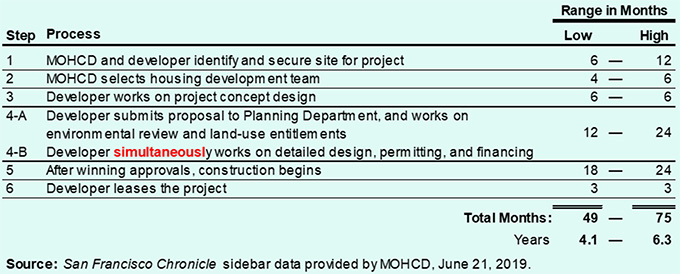
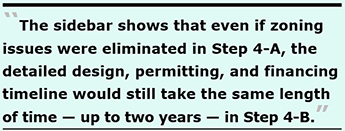 The sidebar shows that even if zoning issues were eliminated in Step 4-A, the detailed design, permitting, and financing timeline would still take the same length of time — up to two years — as in Step 4-B. And the Chronicle mentions nothing about the now going-on four-year delay involved in MOHCD not having yet issued the third $92.5 million tranche of the 2015 housing bond as part of financing in Step 4-B.
The sidebar shows that even if zoning issues were eliminated in Step 4-A, the detailed design, permitting, and financing timeline would still take the same length of time — up to two years — as in Step 4-B. And the Chronicle mentions nothing about the now going-on four-year delay involved in MOHCD not having yet issued the third $92.5 million tranche of the 2015 housing bond as part of financing in Step 4-B.
City Controller's Voter Guide Statements Eviscerate Breed’s Rationales
On July 1, City Controller Ben Rosenfield issued two draft statements to appear in the November 2019 voter guide: One statement on Breed’s Initiative Ordinance to re-zone all Public parcels citywide to allow building housing currently prohibited under zoning rules, and another statement on Breed’s Charter change on 100% affordable housing and teacher housing projects.
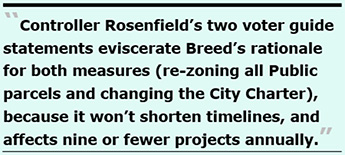 Importantly, Rosenfield notes that Breed’s re-zoning Ordinance might see cost savings, but only if re-zoning the Public parcels shortens the entire process. It won’t shorten the process — as shown in Table 2 above — because the zoning issue in Step 4-A will not shorten the timeline in Step 4-B.
Importantly, Rosenfield notes that Breed’s re-zoning Ordinance might see cost savings, but only if re-zoning the Public parcels shortens the entire process. It won’t shorten the process — as shown in Table 2 above — because the zoning issue in Step 4-A will not shorten the timeline in Step 4-B.
Rosenfield’s second statement notes that only six 100% affordable housing projects have gone through the discretionary review process in the past year-and-a-half and wound up paying fees, and the City anticipates nine or less such projects annually should Breed’s Charter change be passed by voters.
Why make either the re-zoning change or the Charter change, if they will only affect nine or fewer projects? Rosenfield’s two voter guide statements eviscerate Breed’s rationale for both measures.
Vote “No”!
Breed and the Board of Supervisors need to clean house streamlining other bureaucratic delays besides zoning shown in Table 2. Neither of the competing re-zoning ballot measures will solve the other problems.
This squabble should have been handled legislatively, and there’s no reason for voters to be weighing in on this when the Board currently has the authority to do re-zoning on a case-by-case basis.
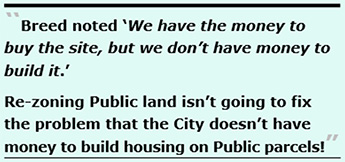 Peter Cohen, Fernando Marti, and the Council of Community Housing Organizations are right: The main barrier to affordable housing isn’t streamlining existing procedures, let alone re-zoning public land. The main barrier is — and has always been — a lack of funding.
Peter Cohen, Fernando Marti, and the Council of Community Housing Organizations are right: The main barrier to affordable housing isn’t streamlining existing procedures, let alone re-zoning public land. The main barrier is — and has always been — a lack of funding.
Take for example the 1515 South Van Ness site the City acquired for “around” $18.5 million for a 100%-affordable housing project. As the Mission Local reported, even Breed noted “We have the money to buy the site, but we don’t have money to build it.”
Re-zoning Public land isn’t going to fix the problem that the City doesn’t have money to build housing on Public parcels.
It’s clear Breed is playing from Wiener’s re-zoning playbook to hand a land-grab blank check to developers.
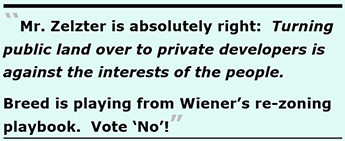 Steve Zelzter is absolutely right: Turning public land over to private developers is against the interests of the people.
Steve Zelzter is absolutely right: Turning public land over to private developers is against the interests of the people.
Monette-Shaw is a columnist for San Francisco’s Westside Observer newspaper, and a member of the California First Amendment Coalition (FAC) and the ACLU. He operates stopLHHdownsize.com. Contact him at monette-shaw@westsideobserver.com.
July 6 Update
News broke over the Fourth of July weekend that the Board of Supervisors Rules Committee will hold a hearing on the two competing ballot measures to re-zone Public parcels on July 11 at 10:00 a.m. in Board Chambers, City Hall Room 250.